#even when we learned it was based on Rebecca it obviously took on new meaning post-joever
Text
Randomly thinking about “tolerate it” (narrator voice: it was not random) and how under the cloak of fiction it is ostensibly inspired by works like “Rebecca” (which Taylor said she read during the 2020 lockdowns I believe?), with the line of “you’re so much older and wiser” indicating that the speaker is significantly younger and inexperienced compared to the person she’s speaking to and a pretty direct reference to the plot of the book.
But I saw something somewhere once that stuck with me about how it might not be referring to relative age between the characters but chronological age as in the passage of time in a relationship. And that made me think about how in a contemporary context, it might not necessarily be referencing an actual age gap between the two characters, but rather a sarcastic or cynical response to the man’s claims that he has matured (“you’re so much older and wiser [than you were before/than you were when we met/etc.]”), which then made me think about that line in relation to the woman. And that it could be taken like, “you act like you’ve matured so much in our time together and like you know everything, while I’m supposedly still stuck as the girl I was when we first met.”
Which then made me think of the “right where you left me” of it all and did you ever hear about the girl who got frozen time went on for everyone else she won’t know it and the bit in Miss Americana where she talks about how celebrities get frozen at the age at which they got famous, and how she’s had to play catch up in a lot of ways not just in her emotional growth but kind of in general. (Which also made me wonder if she’s ever been called out for immaturity/lack of curiosity/lack of education about things in her life…)
Which then made me think about the rest of the song, and @taylortruther’s posts yesterday about “seven” and “Daylight” and the way Taylor idealizes her youth yet contrasts it with an almost sinister reality in its wake, and the line, “I sit by the door like I’m just a kid,” because the discussion raised that her relationship let her recapture some of the childlike joy and wonder she’d lost. So this line is a double-edged sword: the speaker sits by the door with childlike hope that the person will come home and cherish her, but on the darker side, feels like the child dealing with the monsters she doesn’t have names for yet and the feelings of isolation she felt as she aged.
I’m not saying the song is necessarily autobiographical; like most of the songs on folkmore, it’s clearly a fictionalized story based on media she’d consumed and created, but we know a lot of the fictional songs were infused with her own feelings and experiences and… This idea swirling in my head picked up steam and now I kind of can’t stop thinking about it. Sorry but I’m a little obsessed now.
Like maybe it might start to shed light on why she identified so strongly with the novel in the first place…
#the third eye has been opened#😵💫#like tolerate it was always a difficult song#even when we learned it was based on Rebecca it obviously took on new meaning post-joever#and especially in light of ttpd#but the thought spiral i went on last night when i started thinking about all these connections#and the evermore of it all#I’m Charlie at the conspiracy board again#writing letters addressed to the fire#me thinking too hard about Taylor lyrics#evermore my beloved#tolerate it#i kinda gave myself the ick with all this 😵💫#because of the ttpd of it all coming up#and i feel like i remember interviews where Taylor said joe was so well-read especially about like world events and politics and stuff#and supported her when she wanted to start speaking up (not getting into that)#but just based on ~vibes now I wonder if that was like a sore point too at some point#which again i have no proof of but just like… experience with pretentious millennial art bros lol#oh man oh man oh man#this feels like some sort of huge revelation at 1:00 am#when i started writing this lol#eta: when I queued this in the middle of the night i didn't see all the excellent discussion about the seven/folklore posts#so all of you who have been posting about them this morning consider yourselves tagged too!
110 notes
·
View notes
Text
These are “outtakes” from Billie Joe’s 2010 Out Magazine interview. The link is still up, but for some reason they took out his answers about masculinity and femininity????? And those are obviously the most interesting answers! Anyway, here’s the whole thing I had saved in a doc
March 19, 2010
Billie Joe Armstrong Tells All
Photo: Kurt Iswarienko
Our April Broadway issue features Green Day's front man Billie Joe Armstrong chatting about music, politics, and the new musical, <i>American Idiot,</i> based on the band's last two albums. The writer of the piece (and former Popnography editor) Shana Naomi Krochmal filed the following exclusive extras from her interview with Armstrong that didn't make it into the piece. In them, Billie Joe touches on masculinity, his queer influences, and meeting Lady Gaga:
ON MASCULINITY:
Out: Is masculinity important to you?
Billie Joe Armstrong: I think it can come in handy, if it’s used the right way.
What’s the right way?
I think you learn a lot from Little League baseball. Like how to be a good team player, what do you do in situations when you’re at bat and it’s just you and another person. When you lose, how do you deal with losing? When you win, are you a good winner? And a graceful winner? How do you contribute to a team situation selflessly? I think there’s a lot of leadership skills in that. I don’t know if that’s masculinity or just good leadership or just life lessons. I just used Little League baseball because it’s male dominated.
Do your kids play?
They did. My oldest is done now, and my youngest one does. It was a real good bonding experience. I think masculinity is a lot more feminine than people give it credit for. Or it can be. Jim Morrison seemed very masculine to me, but also completely feminine at the same time. That balance in between -- and it’s not those morons on the bus in Borat. That’s not masculinity, that’s insecurity at its worse. Masculinity is something that women can have.
What is feminine about you?
I’m not sure. Let me think. It’s all about being a well rounded a person. I think being a singer is very feminine. Being a singer is a very feminine thing -- performing is definitely. Women have a lot more courage I think than men do, in a lot of ways -- if you think about what Madonna does or Lady Gaga or Beyonce. Women have a much easier time of reinventing themselves than I think men do. Hmm, I think -- a little bit of eyeliner. [Laughs] But I think there’s a big difference between vanity and femininity. I think that feminine side has served me a lot more than my masculine side has in a lot of ways.
ON PERFORMING AT THE GRAMMYS:
That was such a great night. There’s a whole thing where you’re worried about the awards part of it, and it can make you kind of irritable, kind of stressed out. But the great thing is that we had a chance to play with the cast, which has never really been done before.
ON THE MOST EMOTIONAL PARTS OF THE SHOW:
When Rebecca [Naomi Jones] sings “Letterbomb,” that really blows me away. The scene where Tunny’s on the gurneys and they’re singing “Before the Lobotomy.” And “Last Night on Earth” is an amazing scene with the couple doing this heroin dance. Tony [Vincent] is singing the song -- the first verse while they’re slamming smack -- and then the next verse is Mary coming out with a baby that she’s had with a guy who turns out to be a loser father. I get chills thinking about it right now. The juxtaposition between the two scenes is like -- wow.
ON WRITING AN ORIGINAL MUSICAL:
I’d definitely be interested in it. I think we’re in a really rare situation where this is gaining momentum. I don’t want to screw it up by working on something else. I’d love to do something with Michael [Mayer]. I’ve always wanted to see what it would be like to score a film -- but this, this is even more special, I think.
ON KNOWING TOO MUCH:
When you start getting into politics, what I’ve realized is that if it seems to be black and white, it’s shooting off into so many different directions. You can’t really keep up with what’s happening in the House of Representatives. Things like Hurricane Katrina, Haiti, troops in Afghanistan, financial crisis -- even Tiger Woods. It seems to be one thing after the next.
ON HIS QUEER INFLUENCES:
My uncle. There were different punk singers, from a guy named Cretin Chaos in Social Unrest to guys like Morrissey. And also guys that would genderbend a little, like Bowie, or Mike Ness from Social Distortion wearing makeup. I’ve always liked music that was non-gender specific, like the Replacements song called “Androgynous.” It was just always those little things or people that were willing to make you think, whoa, that’s not what I’m hearing on the radio these days.
ON MEETING LADY GAGA AT THE MTV VIDEO MUSIC AWARDS:
She had this outfit on -- she had so much shit on her when she walked by! She couldn’t move her arm because she was going on to do her performance, and it was like shaking hands with someone in a cast. She had this handler that was like, “Don’t touch the costume! Don’t touch the costume!” She said something about how she loved Dookie so much she used to lick the pages. I thought it was really cool. She’s influencing a lot of young people, and she’s doing it in a way that’s provocative. And a lot of people don’t realize that she’s an artist, and she’s been one for a really long time. She’s taking something that Bowie or Madonna did and taking it a step further.
ON WHAT IT MEANS TO BE “PUNK ROCK”:
That’s like a 10 part answer. I think of it as something that you need to have of your own. For me it’s about community. I think it’s kind of spiritual in its own way, because people fight over it so much and the meaning of it. It’s a sense of self-discovery. But also a new set of ideas and a new poetry, a new music that you discover that you notice that no one else is really into, or goes against what other people are normally into. It’s like you’re free to be an individual and taking on new ideas and challenging old ideas. I think it has a lot to do with burning down the establishment to create something new. But at the same time, you find relationships within that too. It’s something that’s supposed to empower you. It’s about starting something new. Part of the problem with a lot of punk rock is that people believe that it’s supposed to be one thing. Everything for me starts off with punk rock when I’m writing songs -- it’s almost like I’m stripped down to the bare bones of music again. It’s kind of in my DNA in this point.
ON HIS WIFE, ADRIENNE:
She’s great. She’s beautiful. Without her, I don’t know what I’d do. She empowers me to challenge myself in a lot of ways. She inspired the song “American Idiot” by playing me this Midnight Oil song that she really loved. She runs a store called Atomic Garden, all about sustainable living. She’s really active in NRDC, politically. Sometimes I think she’s a hell of a lot more interesting and a cooler person than I am.
ON HIS “MISERABLE” HIGH SCHOOL EXPERIENCE:
Academically you have to completely re-figure out how to prioritize your life. And suddenly you feel like the whole fucking world is against you because they’re prioritizing for you. And it’s forced on you. And if you don’t get it at that age, if you don’t catch it -- that’s what happened to me, I didn’t prioritize anything. I just got to a breaking point where it was like, by my later high school years, “You’re all full of shit anyway. Everyone’s full of shit. I know what I’m doing, and fuck school, and fuck schoolwork, and I’m not going to go to fucking college anyway, and I’m gonna play in a rock band, and you’re all gonna be sorry.” You get vengeful -- it’s a natural instinct, all those hormones going and shit.
ON BEING HAPPIER AT AGE 38:
I kind of feel like things are getting better. It goes in stages. I loved my early twenties. I hated my late twenties. I was a drunk. I was trying to figure out how to be a father, a husband, but I still wanted to live my life like a crazy punk rock rock star. You start noticing things about yourself. You have to change your health habits. But you don’t want to change. In your twenties, change is hitting you over the head whether you like it or not. Right when I got to about 30 I was like, thank God that’s over. But it gets complicated again.
#Billie: 'Masculinity is something that women can have'#Me: 'OmG hE's TaLkInG aBoUt Me'#article#interview#articles#billie joe armstrong
51 notes
·
View notes
Text
seaglass blue annotations
hello! i just posted the last chapter and thought i’d put together some ~fun context~ for that fic. it got way way more attention than i ever expected and for something i feel i didn’t put that much effort into i think i did in the end put a lot of effort into it so i might as well talk about it and answer some potential questions.

my favorite book of all time is the sunlit night by rebecca dinerstein (yes, that one) and something i find really compelling about that book is how sparing the prose is, forcing the reader to fill in certain gaps, and i think having to fill in those gaps makes the book a really acquired taste with which either you love it or hate it and there’s not really an in-between

i also really adore how in that book the natural world backdrop comes to life, something i find really challenging to write. recently i even read into thin air, the book about the 1996 mount everest disaster, and even though the writing was superb, i still had to google what the hillary step was because i couldn’t picture it on my own. i don’t know how people write nature because to me it feels damn near impossible, but this sparing approach really worked, so i thought i might try it out. i tend to be longwinded (gestures vaguely at this post) and wanted to have certain parts of this be a lot smaller and more contained without negating impact. whether or not i made it work is anyone’s guess. definitely not my normal style, so to speak

based on the comments i’ve received i think this might be everyone’s favorite part. in my mind age of consent by new order was playing in the background. in pretty much every fic i have a scene like this one and all of them are based on the poem first base gold by rh*annon mcg*vin from her book branches (censored because she has a tumblr and i don’t want her seeing this haha)

i absolutely can’t do the poem justice by describing what it’s about, but the simplest, most basic interpretation of the poem is that there is no better place to kiss than right here, right now, because of the past. i really like that imagery and tend to use it a lot. she as a writer has been a big inspiration for me and if you’ve read my fic true minds i should add that the nonfiction inspiration for that was directly as a result of one of her youtube videos. i particularly love how the last paragraph (stanza? im not a poet) is one big run-on sentence that’s jovial and tongue-in-cheek and colloquial and straightforward. it feels triumphant in a quiet way to me and i love how it’s done. obviously my attempts at something similar are nowhere near as insightful, but still, the most basic image of this is that there is no better place to kiss, and that’s how i felt about the two of them finding pudding in the supermarket
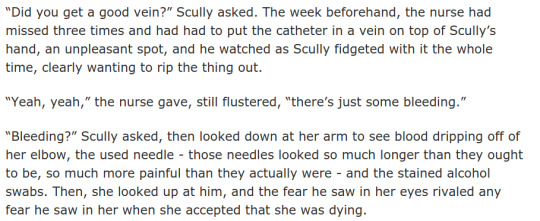
this part is autobiographical; while writing this last year, i went through six months of intravenous drug treatment, a month and a half of which involved long days of doctor visits on every weekday. when you’re on stuff like that for a long time you end up with a central line for better access (potential plot hole in all of this: scully never had one) but for a month and a half i got poked almost every day and strangely enough it got harder over time. the first couple you never feel, but a week or two later you start flinching, and if the needle goes in the same vein each time, it hurts the more it gets prodded. i reached a point toward the end of the in-office visits in which i would bleed a lot every time i got poked, and i can’t watch anything like that happen to me so i was looking away each time, and when i felt that the nurse was done, i would look back over, and sometimes i would be looking down at a pool of blood that i hadn’t expected to see. it’s weird, you don’t actually feel yourself bleeding, i would’ve expected a hot bloody feeling but instead it felt like nothing. and when i say a pool i mean that it would drip down beneath my elbow, stain the sheet they’d put underneath, and i wouldn’t get all of it off until i showered. i didn’t necessarily find it scary, but it was surreal and kind of pulled me out of normalizing the experience i was having. for a very long time needing iv drugs was my greatest fear and i was surrounded by that then and fine, and then, there was blood all over my arm, and like, haha, this is actually not fine. you’d think something else would’ve been scarier, but it wasn’t. and now looking back at this paragraph i wish i’d edited it differently but hey that’s life

i’d never really understood the purpose of religion as a self-driven part of life until i took anatomy in college. i was raised catholic and though culturally i understand having a religion and being raised with one, i’ve never really reached for religion when i wanted answers, and i haven’t personally understood why that’s someone’s first option. and i know there’s been plenty of commentary on the hypocrisy of dana scully as a catholic who believes in science, yada yada yada, i think everyone has read all of that by now. but what struck me while learning anatomy is that there is a kind of neuron we don’t know the function of. there are four kinds of neurons, and one of them is still a mystery to us. and then, there’s all of these different parts of human bodies that exist in a certain perfect way, but why do they exist like that? to support life, yes, but why is it that we can make comparisons? why were irises not the same color? and we name valves of the heart after religious figures. we are so hell-bent on meaning that something literal will never be enough. and all of that made me think that dana scully has god to fill in what science won’t answer, at least not yet. and there’s definitely a bigger conversation about science as denial of indigenous cultures that i am nowhere near qualified to start. after taking those classes, i think i would be more shocked if she wasn’t religious. you can ignore pretty much all of the paragraph above but it was important to me that at some point in this fic she willingly conceded that she didn’t know what would happen and that she didn’t have answers. with illness, there is no logic, there’s no thinking your way out of it, and i think that would plague her for a long time. to me, she only would accept her death when she could say she had no idea what would happen, she has no answers, there’s nothing filling in her gaps anymore, and she’s comfortable with that. and i put all of that in a paragraph about my thoughts on god because it made sense to me. there are times that just feel like you’re in a movie and there’s no one else you can say caused them. it’s not enough to build belief on but it’s enough to bring a certain kind of wonder. also one time my parents insisted on watching stripes because it was so funny and when watching it none of us found it funny at all and my parents grimaced and were like what were we on that made that good back in the day so that’s in here now haha
and now, the biggest question: does she die at the end? when i came up with the idea for this fic, i knew the beginning and ending but not the middle, and i posted this as a smaller project (ie: chapters below 3,000 words) while illness made my bigger projects harder to work on and essentially flew by the seat of my pants the whole time. i wrote the last line a long long time ago and have always seen the ending as written as the concrete ending. when i started writing this, i never intended for there to be a definitive answer to whether or not she dies. i like premature endings (the ending of girls burn brighter comes to mind) and i think that this works better without saying whether or not she lives. and i also have a hard time with giving a definitive answer because this fic very much is about death and having her die would, of course, be traumatic, but showing her living instead i think ruins any takeaways people could have. i’ve never had cancer but as a chronically ill person i think i can speak to how you never actually win with illness; the best you can do is tie, and sometimes, no matter how much effort you put in, you “lose” anyway, you lose spectacularly, and all of your effort was for nothing. i wholeheartedly believe that humans can’t emotionally or logically process natural disasters or illness, hence why much of the talk about illness in this is from mulder’s perspective as he experiences her terminal illness secondhand; that way, he doesn’t need to (but still likely will) find logic or reason or meaning for death from a terminal illness, so his discoveries and his coping mechanisms aren’t as urgently needed. had i written a chapter that describes how she lives, i think that the discussion of death in this would be voided altogether. and i also don’t believe the ending would be much different whether she lives or dies; there’s still the need for death acceptance and talking about dying, whether or not she lives, and none of the story in this fic would have happened had the characters known she would live. the whole point is not knowing.
for a little while i toyed with writing an unofficial sequel of sorts in which i spelled out what i think happens after the ending, but after realizing that that would end up being longer than the original fic and would also have some massive plot holes, i decided against it. i do have my own version and i don’t want to share that version because i never really intended for my version to be some kind of genuine sequel in which every question gets answered and everything is wrapped up and happy ever after and whatnot. it was just where my brain wandered in the same way it wanders when i watch an open-ended movie. all of that to say, if you think she lives, then she lives. if you think she dies, then she dies. it’s your decision. i’d much rather you choose than me. i never marked this as “major character” death on ao3 because, well, she doesn’t die in this fic. whether or not she dies after the fic ends, that’s for you to decide.
thank you for taking the time to read my writing. i never expected this to blow up (it blew up for me at least, for a while it was my most popular fic ever, with i think thousands more hits than anything else i’d written) and the response has been mind-boggling and wonderful. i don’t respond to comments often because it makes me feel like a pompous jerk (”thank you for enjoying this! i, too, enjoy this thing i have written! oh ho ho!” is how it sounds to me in my head, whereas when other writers respond to comments to me it just looks like thanks man have a good day, feel free to call me a weenie) but i’ve appreciated all of them very much. THANK YOU! i hope your new year is a Whole Lot Less Shit than 2020. i don’t plan on writing more msr because i don’t really have any ideas for them. thank you for making my last time special <3
20 notes
·
View notes
Text
Steven Universe: Art and Origins (Outline & Review)
Steven Universe: Art and Origins is not just an art book--it's also a collection of early material, a reveal of many initial concepts, and an amazing experience to sort through.
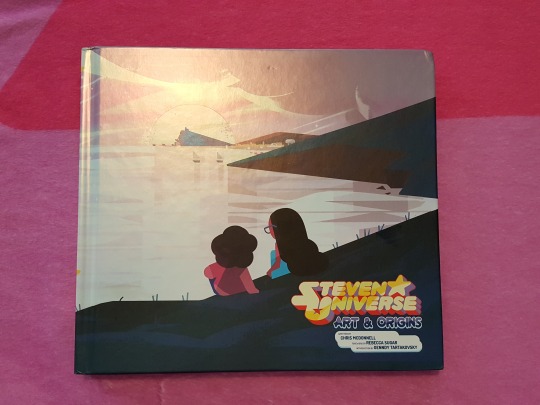
Finally getting around to importing my review to Tumblr. I wrote this on the release day.
In my review I'll give you a description of the structure and overview, while also collecting notable information for fans. Obviously just about everything is "notable" with a book of this magnitude, so this may get long, but I'll try to include anecdotes that have some unique insight or perspective on the main source material--with as little of "OMG this was the original idea for this!" as possible.
This is illustrated with some low-quality pictures of the book and it gets super long, so I have to cut. But please read. :)
The overview:
After a foreword from Rebecca Sugar and an introduction from Genndy Tartakovsky, we get:
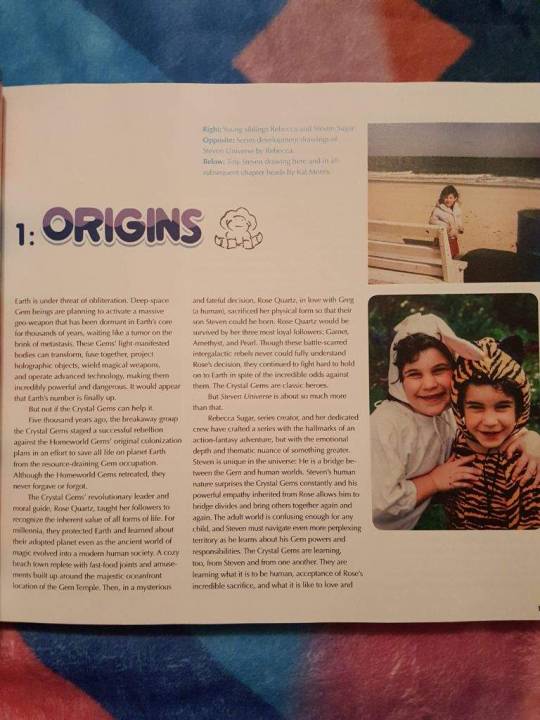
Part 1: Origins. This contains some narratives about Rebecca Sugar's early life as an artist--inspiration, family, college projects--all illustrated, of course, with childhood photos and early art. Rebecca mentions having wanted to bury her femininity for a while, but coming back to draw female forms and include dancing after she learned to sort through her issues using art.
Her college education and connections with other artists are discussed--some in interview format, some in narrative--and there is some background regarding her time on Adventure Time. The story moves on to talking about developing the pilot and what went into her character and plot ideas. Character design is discussed in depth, with Rebecca giving initial sketches to a design team and developing the characters' initial pilot look.
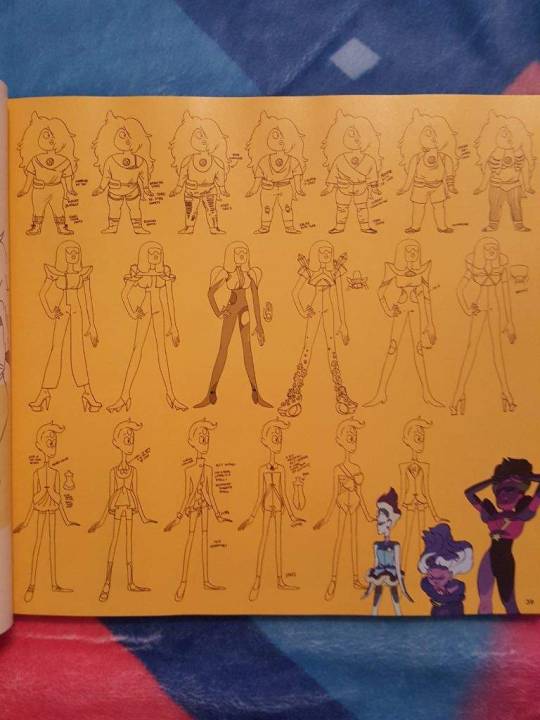
Some really slick promo art is shared--posters, sketches, great concepts that were designed to bring in new viewers and make them curious about the show. The pilot succeeded in getting the green light to develop it into a TV series.

Part 2 discusses the show's Green Light and Development. Rebecca and some of the other crew, in interview format, talk about getting the team together and allowing for both nailed-down character essentials and flexibility for the writers to explore and collaborate. Developing the setting was also a big part of the to-do list; coming up with Beach City itself, its businesses, its residents, and also the creatures the Gems would fight.
Some cute stories are shared about the early Crewniverse hanging out at a cabin and talking about the show all the time, hashing it out. There are some great, loose character model sheets for early versions of Greg, Connie, Sadie and Lars, and the four main characters.
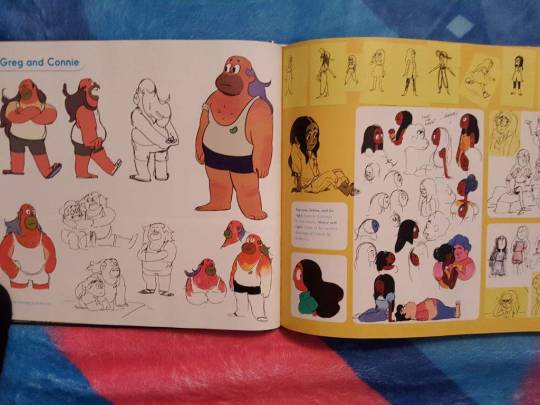
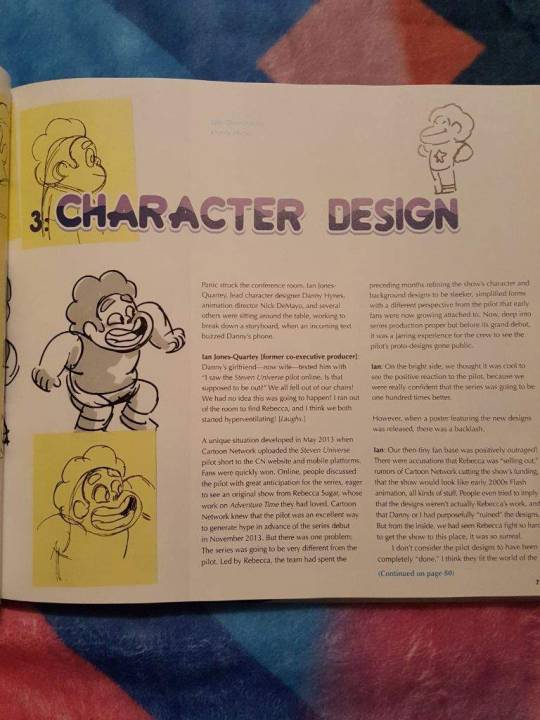
Part 3 is about Character Design. They discuss how the pilot got released and fans grew attached to what they initially looked like, only to be "outraged" by the changes, making tons of assumptions about who was controlling the process.
Rebecca shares some thoughts on her development process and her philosophy on letting different artists draw the characters differently while gripping onto specifics she set. Main, palette, and distance models are discussed, with some technical details of what different artists do on the team and how they handle props or special poses.
There are many sheets of how to draw the Gems on model (with pointers on what NOT to do), and then there are some Homeworld Gem ideas that didn't get used, and finally, some sketches and concept art for Lapis Lazuli, Peridot, Jasper, and Bismuth.

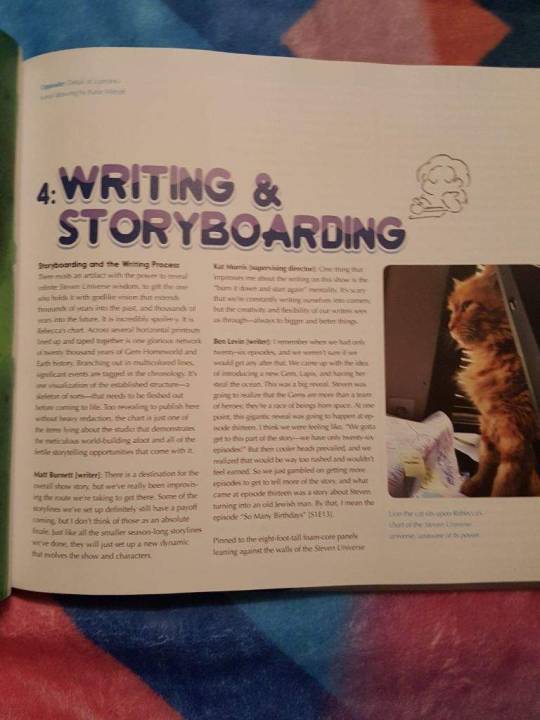
Part 4 is on Writing and Storyboarding. More Crewniverse interviews provide insight into the process, including how much is revised from the early days and how collaborative everything is. Some specific episodes, like "Ocean Gem," "Monster Buddies," and "Island Adventure" are put into perspective with how they were written by the group.
There's heavy discussion of how the process works and why processes that work on other shows wouldn't work here, and what "rules" are firm and what's just a suggestion, and what's changed as the show's plot became more complex and important. Steven still having access to the "side" stories, the ones that involve Beach City humans and non-world-shaking stakes, is still very important to the story that the original Crew wants to tell. Cute images from the Crew's thumbnail storyboards, Gem designing, and technology designing workshops are shared too.
There's some good continued discussion of concepts in Part 4, especially about fusion and relationships and the larger message the show is sending. How do you tell a story and why? There are many answers to that, and sometimes it's about fun and sometimes it's about a message and sometimes it's about wanting to make an episode about something you've never seen a cartoon do before--something specific to you that other people can suddenly see represented.
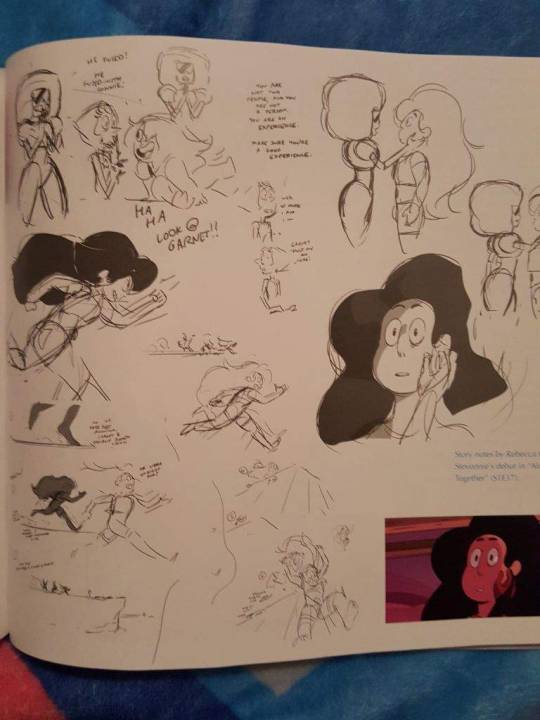
One of my favorite parts of it is when they discuss Steven discovering the Gems' weaknesses over time and having that NOT make him think less of them--more like he admires them for being strong enough to shoulder the burdens he didn't know they were carrying before. Storyboarder Lamar Abrams talks about the importance of growing up not just being about becoming bitter, and I really like that.
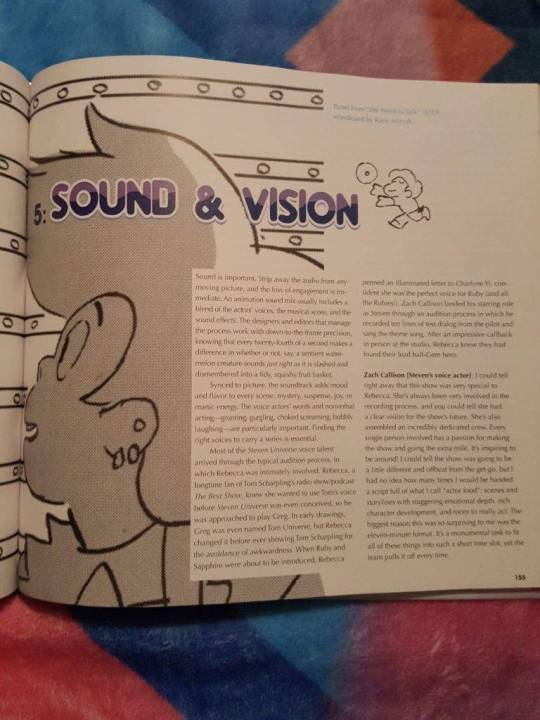
Part 5 is on Sound and Vision. There's some history of how they found the voice actors for the major roles, and some of the actors give perspectives on their relationship and experience on the show.
Aivi and Surasshu, as the composers, discuss their process as well, with some anecdotes and discussions of why musical palettes work better for characters instead of assigning them themes. Places and objects have their own sounds too.

Part 6 covers Background Design and Painting. Steven Sugar takes the stage and explains general background thoughts as well as specifics for certain settings. His focus on detail is really fascinating to read about--it's really him who nails down the locations in Beach City and where an outlet is in a house on the wall.
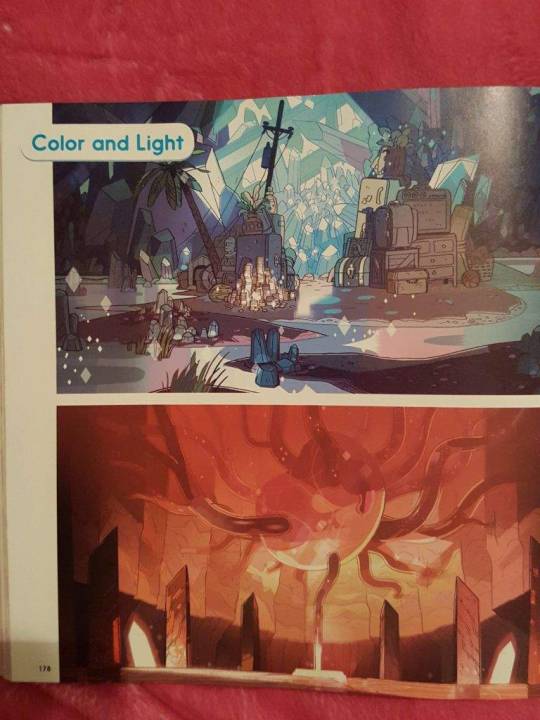
The directors and other Crewniverse folks discuss the use of color and background items in the show, and how they use it to create mood or feel changeable enough to be real.
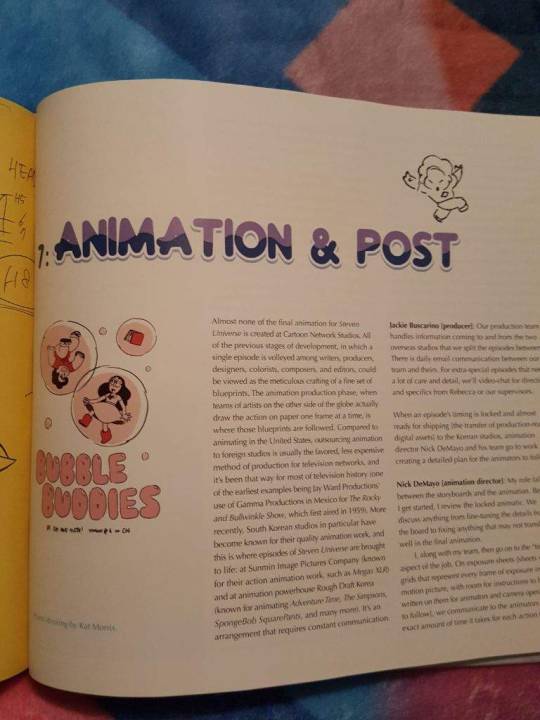
Part 7 discusses Animation and Post, with a spotlight on the work they do in Korea at animation studios Sunmin and Rough Draft. The process is described--how and when the material is transformed from animatics to animated cartoons.
Nick DeMayo discusses timing and adding the sound effects and whatnot. There's also some design instruction that's provided to the animators in Korea.
Some special highlighted drawings and pieces, like the "C.L.O.D.S." zine or some keys for Ruby and Sapphire, are included.

Even the bumpers and end tag animations are discussed here. And of course they had to mention a couple very special episodes, such as when Takafumi Hori from Studio Trigger came in to do "Mindful Education," or when they did the musical episode, "Mr. Greg."

And Part 8 is called "Onward." The intention of the section is unclear at first based on the title of the chapter, but you can quickly see they're discussing the forward-thinking message the show has--how its representation of its creators' experiences has also struck a chord with people who wanted and NEEDED its diversity.
Zuke says a very wise thing when they state that they want the show to provide "insight . . . not a solution." That's one thing this show does well; it spotlights problems and situations and feelings, but only shows you how those things can be dealt with, not necessarily how they SHOULD, in all cases, be dealt with.
Representation matters, and seeing evidence that you are a part of this world when you're from a marginalized or underrepresented group is valuable in a way that you can only know if you DON'T have it.

The show's writers also weigh in on good vs. evil and how it's too black and white; that we needed a show with nuance, and has a message of love and tolerance. Kat Morris acknowledges that there are more important things than making a feelsy and entertaining piece of media, but as she says, the point is to let people see themselves in something and be challenged.
And the creators are able to see at conventions and online that people are responding emotionally, viscerally, to their work. It puts a lot of pressure on an artist to do it right, but in the words of Dogcopter, "Just be true to yourself and people will appreciate your honesty."
The book closes with some photos of the Crew and a few more pages of art. And it kinda leaves you with a squishy feeling. :D
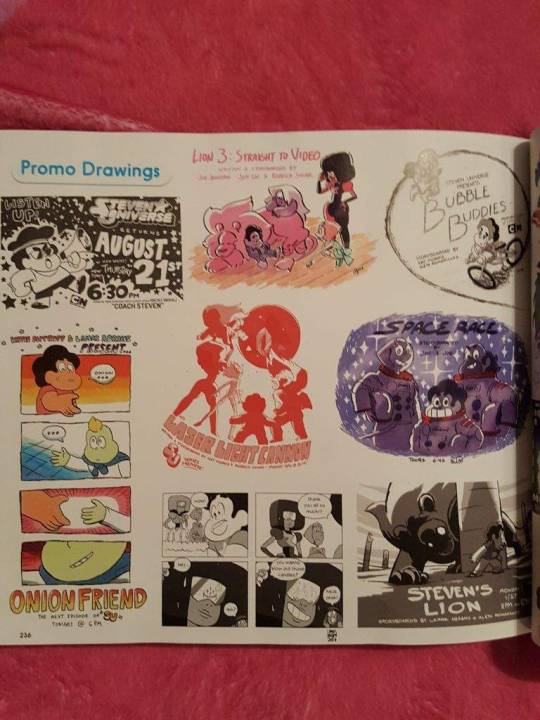
Notable:
1. I was relieved to see Rebecca state it plainly in the foreword: the items you see from the development phases of this show are not to be taken as canon or as "real" insights into how you should interpret it now. She specifically mentioned that she does not consider the Gems "girls" or "goddesses," and that was particularly important to me.
Throughout, you're supposed to see the contributed bits and in-development pieces in the context of what they were: early drafts, embryonic. We all become different from what we were even though we grew from it and may have roots in it still, but that doesn't mean you can point at the seed and say its flower is meant to be understood surrounded by dirt.
2. The original designs for the Gems fluctuated a lot, and in a couple cases even names flopped around. An early name for Garnet was "Onyx," and if you've seen the pilot, you know Pearl got her signature nose later and Garnet's hair took a while to become the splendid square afro. Amethyst seems to have changed the least.
Themes were given to them initially (like Amethyst being "flora and fauna," which you can sort of see in her pilot intro with her lying on big cats). You can still see some of the original intentions in how the ideas manifested, but the first ideas do not gel particularly well with what the show became.
This is particularly interesting because non-creatives commonly think creative people simply receive inspiration and birth their creations into the world wholesale. Inspiration exists, but it's much more common to take an inspired idea and REALLY WORK ON IT. This book's origins section does a great job showing how that works.
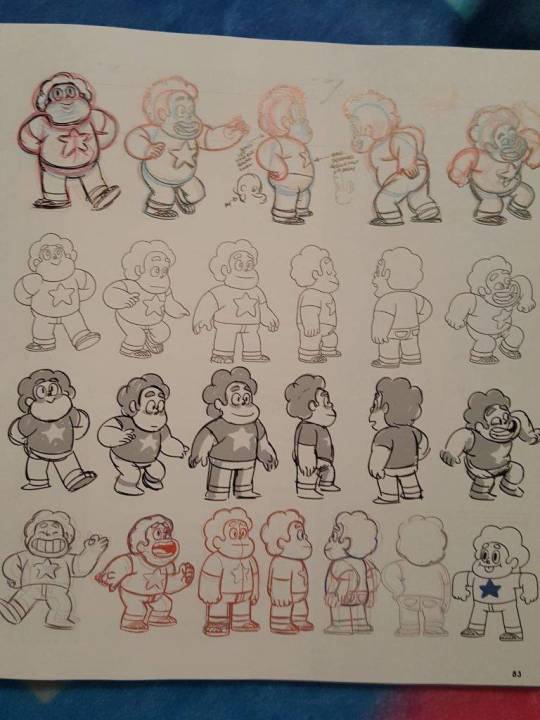
3. Some early sketched-out ideas for episodes seem very far from what would fit into the show now (such as an idea for an episode where Pearl is obsessed with the pizza guy??), but one seems to be the roots of "Bubble Buddies," which implies that Steven's original crush was "Priyanka" instead of Connie. (That's now Connie's mother's name.)
4. The pilot's title was "The Time Thing."
5. Initial notes for Garnet say she should have the coolest shoes of the three, that she's commanding and outer-spacey and also weird, and that she's inspired by Grace Jones, boy Michael Jackson, and Estelle in "I Can Be a Freak."
Initial notes for Amethyst insist on the "fanny pack" pouch and suggest her clothes are cut, her hair is in chunks, and she should have an animal theme with a wild texture.
Initial notes for Pearl indicate a desire to have her opposite Amethyst in her formal way of dressing and needing to have an outfit that would allow her to be hung upside down, possibly with a pearl stone theme for baubles in her hair. (Rebecca indicated she needed the most help with Pearl.)
6. Early versions of the show included the idea that the Gems might be trying to hide being Gems in public, and that they kept magic away from Steven for the most part instead of encouraging him to use it.
A "lost" episode about Steven summoning his shield (later incorporated into the episode "Gem Glow") had him saving Greg with it and dreaming about his mother, and having Pearl drive a crappy old car (later incorporated into "Last One Out of Beach City"). Rebecca and Ian reveal that the dream Steven had in it was used a little in "Rose's Room," and that a song called "The Meatball Sub Song" was involved which could have contributed to the show getting picked up despite that we never got to hear it. (Imagine that, Steven singing about food!)
7. There's a note in the early character design section that says "the girls can all turn into Steven" with an accompanying illustration of Garnet, Amethyst, and Pearl shapeshifted as him.
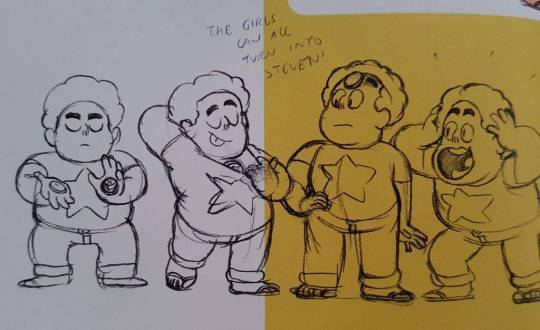
Cute, because we actually got to see them do this in the episode "Keep Beach City Weird" with the exception of Pearl.
8. Rebecca Sugar shares an anecdote about thinking there was a "best" way to draw that was objectively correct (influenced by some art-school stuff), and through that she arrived at the idea that Pearl was a cone, Amethyst was a sphere, and Garnet was a cube, because all of those things say something about who they are (pointedness, fluidness, stability).
She evolved from that idea to a more flexibile idea of how drawing works for different artists, but that was part of what helped her nail the characters down. Steven, eventually, was fixed to having a heart-shaped face.
9. The Tiger Millionaire and Purple Puma flyer shown in the episode "Tiger Millionaire," presented as something Steven drew, was actually drawn by Lily DeMayo (daughter of Nick DeMayo, animation director) when she was seven.
10. Guides are made for the Crew to use featuring reminders on drawing the characters. It's kind of adorable to see common drawing errors or misconceptions or inconsistent details discussed in a how-to format for the people who actually work there.
11. A timeline exists for the show and it encompasses TWENTY THOUSAND YEARS of Gem and human history. It was too spoilery to be in the book, but there is a LOT of lore that is laid down, and this tool mentioned in Part 4 established that this document is referenced often to make events make sense in the timeline.
12. It's been established before, but Amethyst's origin in Earth's Prime Kindergarten was not initially known as part of her character when she was invented, and that was discussed in Part 4 of this book--how the writing retreats the Crew takes to discuss the story sometimes result in huge revelations like this. "Oh, that makes sense, that's why we wrote her like that" is one of those things I recognize as a writer--you know a character has a certain vibe, but you don't know what explains it. You just trust that something does. And eventually, sometimes you find out what it is and it all makes sense. Interesting to know they did this with Amethyst.
13. "Lars and Sadie make out even though they're not together" was the basic idea for making "Island Adventure." And the original idea for "Onion Friend" had a "Grandma Shallot" character.
The writers sometimes play writing games to brainstorm, and those were shared. Some ideas for a story which was later used in "Future Boy Zoltron," covering Mr. Smiley's romance/comedy partnership with an old flame, were shared with more emphasis on the characters being lovers.
Garnet's part in the story was more explicit too, with her giving people future predictions that are not at all nice or gently delivered, and they have to shut down the business in the wake of Garnet's badassery. Weird.
Other ideas were used but not as they're presented, like one where Greg learns about fusion from the Gems (but witnessed the fusion of Pearl and Amethyst, not Pearl and Rose), and a complicated one where cross-Gem fusion is a new idea in a flashback and Rose wants Garnet to fuse with her to teach her about it but she's too unsure of her own fusion relationship as such to risk it. The idea was that Pearl would be jealous and Pearl, Rose, and Garnet would actually fuse in the episode. This has not been done in the show.
14. Rebecca Sugar apparently just pops up with concepts she wants the writers to work in. Like "I want Steven to be in a mushroom forest" (which hasn't happened yet) or "I want Steven to have cats on his fingers" (which, obviously, happened early on). Rebecca gets little concepts that are sort of dreamlike, and they figure out which episode they can put them in. Working those things in sometimes seems like as much of a priority as getting plot elements in!
15. I like that they dish a bit about the fan reaction to Garnet's Fusion status. They thought they were being a little too obvious to not get caught, but Ian said the fans figured it out and then got bored of the idea and decided it must be even more complicated than that. People were apparently worried that Garnet would be replaced by her component Gems in the story if she were to unfuse, but obviously since Ruby and Sapphire want to be together, that doesn't happen.
16. Kat Morris's "rules" as discussed in Part 4 are "Garnet never asks questions" and "the story has to stay in Steven's perspective." I love how strict they are about Garnet not asking questions (except in the episode "The Answer," though there have been a couple ~technical~ questions from her; she usually just finds a way to ask a question with a statement, like "tell me what you saw").
17. A great quote from Zuke on the incidentally queer content of the Gems' relationships and gender: "Personally, I'm happy to not have to think, 'I'm writing a character based on my queer experiences.' That would be so hard! I'm just writing from my perspective, and I happen to be queer. I think that's what makes the show feel natural when it comes to that. It's a fine line between defining something so that people are aware it exists, which is so important, but also letting it breathe, so it's not forever contained in a box labeled 'queer media.'"
18. In Part 5, Michaela Dietz relates her experiences as an adoptee to relate to what Amethyst deals with as an "adoptee" into the Crystal Gem family without knowing where she really came from or what it means to be a part of that. She's said this before in some other interviews and panels, so it's not new in general, but it's probably new in print. Deedee Magno Hall, who plays Pearl, obviously relates to Pearl's maternal nature.
19. Tom Scharpling and Charlyne Yi were voice actors that Rebecca specifically had in mind for her characters (Greg and Ruby respectively). Rebecca's illustrated letter to Charlyne explaining Ruby and Sapphire's relationship and Ruby's role on the show is really adorable.
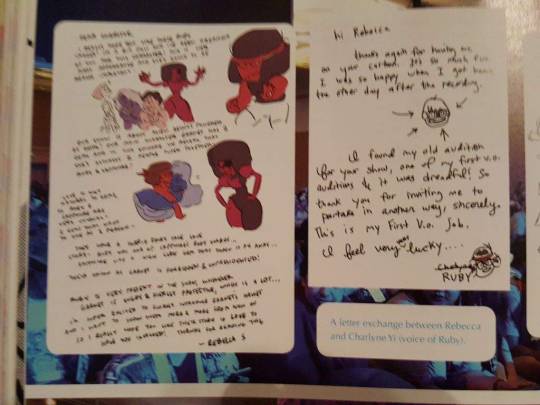
20. Music nerds like me will very much appreciate the photographed notes on music motifs--the Diamonds each have a solfège syllable and a chord (White is F#M7/Sol, Yellow is BM7/Fa, Blue is EM7/Fa, and Pink is AM7/Mi), and Steven's powers and modes are coded with instruments and styles.
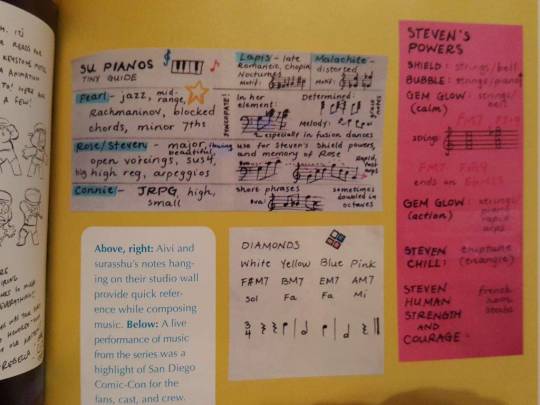
21. Some world maps provide new possible insights. Greenland in our world is Blueland in theirs. South America is called Pangea. Aqua Mexico is labeled about where Mexico is in our world. India is the Indian Islands. There's an Australia and a New Australia. A big sea in the middle of Asia is called the Tunguska Sea. Rose's Fountain is in Spain or Portugal; the Sky Spire and Strawberry Battlefield are in Norway; the Shooting Star Shrine is in the middle of the drastically different Asian continent; the Galaxy Warp is in the Tunguska Sea; the Lunar Sea Spire is off the coast of Canada; Mask Island is in the Atlantic near Beach City; the Comm Relay is in the Western United States.
22. It was known from interviews that Shelby Rabara (voice of Peridot) is a dancer and provided the foot sounds and coaching to create the short tap number in the episode "Mr. Greg." But what's great is here, there's a visual reference included! Photos of Shelby doing the dance are lined up next to the drawings of Pearl and Steven in the "Mr. Greg" number doing the steps! She poses in dance moves with her husband for the Greg/Pearl dance for "Both of You" too.
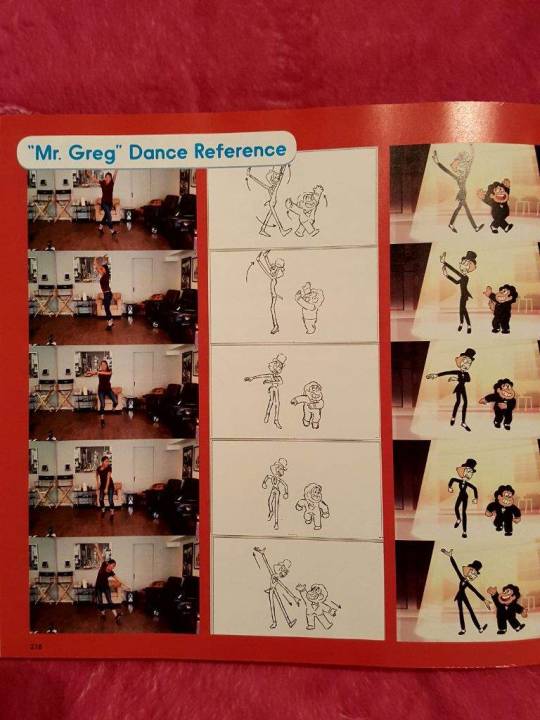
23. There's a really cute story in the last section about Amber Cragg ascending from fan to Crewniverse member through posting Pearl art in response to the pilot and eventually getting contacted to take a board test. That is the kind of thing so many online artists dream of!
[SU Book and Comic Reviews]
#steven universe#steven universe reviews#steven universe art and origins#steven universe books#rebecca sugar#myblog
112 notes
·
View notes
Text
I’m a LOUSY Blogger!
But Let’s Get To Improving That!
Well, obviously, I forgot for a while that I even had a Blog! Shame on Me! That being said, let’s start by Re-Introducing who I am, what I do and what we’re all doing here in the first place!
I am Melisa. I’m 51 years of age and I have been married to my high school sweetie since 1988 and his name is David. We’ve been together for 33 years in 2020. David and I share three beautiful grown daughters, Brittany, Kymberly and Krystina. We have six grandchildren: Jessica is 11, Rebecca is 10, Katherine is 7, Joshua is 7, Annalyna is almost 3 and our newest is Zanora, born October 18th of this year. We also have four “Fur-Babies”. A Chihuahua/Pomeranian mix named Peanut (She’s almost 9 years old), a Papillon named Popcorn (She’s almost 5 I think!), her full blooded sister Caramel (If Popcorn is 5, Caramel is 4!) and our most recent addition is Bella (she’s about 5 too, I think) Bella was my Mom’s baby. My Mom passed away a few months after she got Bella. At the time of my Mom’s passing, we didn’t want to give Bella away, and Krystina adopted her and loves her to death. However, with the recent new addition of Zanora to the household and Annalyna being a normal 2 year old, Bella inevitably “nipped” at Annalyna. So, we took Bella….for now. Who knows, she might go back to Krystina’s house, only time will tell.
What do I do? Well, I’m actually a trained Medical Assistant and Phlebotomist. I worked for a handful of doctor’s in my native state of California after graduating from school. One of my favorites was working at an Urgent Care facility where I got to see all kinds of illness and injury. But the job I enjoyed the most, was working for the Chief FAA Medical Examiner of Los Angeles County. I was in charge of the lab, ran all kinds of tests, took X-Rays as well as a myriad of other things. I loved the patient interaction and helping people get and maintain the ability to fly, through their Federally Mandated Physicals. However, David works in the Aircraft Industry, which at times, can have a high turn over rate, so you go where the jobs are (The main reason we’ve lived in 6 states throughout our marriage!) and we ended up moving to the state of Arizona from our home state of California. After graduating school and working in my field in those offices, I eventually found work with the local school district my daughter attended as a substitute Health Office Technician. After a couple more moves, and a couple health issues on my part, as well as the death of my Dad from throat cancer, we moved back to California to be closer to my Mom and Sister, Annette. Because of my love of cooking, during this time in California, I also attended Culinary Arts School. However, my husband David was working in the aircraft industry and after 9/11 happened, unfortunately the jobs in that industry dried up and he had to find “side hustles” to make ends meet as he looked for other employment within the industry. Then one day, one of the job applications he put in, panned out! The Federal Aviation Administration called and offered a job, and he took it, which facilitated our move to the state of Kentucky where we had lived before when David was serving in the U.S. Army during Operation Desert Shield/Storm. We had always said we loved Kentucky and had talked about retiring there, so THAT worked out well!
After moving to Kentucky, our two youngest daughters finished high school and our oldest daughter’s then husband, had joined the military and she came to live with us while he was doing some training. She brought with her our Granddaughter Jessi and her pregnant tummy! As my birthday approached, so did her due date, and on my Birthday (November 19), I took her to the doctor and they announced she was going to have a baby that day! So, Rebecca (Nicknamed Reba!) was my Birthday Present that year!
During Brittany’s stay I ultimately had my first back surgery where I had a titanium cage installed and a fusion done. At this point, I was no longer physically able to stand for 8 to 10 hours a day meeting the physical demands of the job I enjoyed. So, I threw myself into my hobbies of counted cross-stitch, crocheting, reading, cooking and scrapbooking.
After living in the suburbs of Louisville for a couple years, we bought a house 30 miles away in the little town of Shelbyville. By this time, Kymberly had moved back to California after graduating high school, and Krystina had just graduated. Brittany had moved back with her then husband, out of state again. (😥)
Krystina moved out eventually and it was just David and I our dogs Rotunda (another Chihuahua/Pomeranian mix who was 12 years old), and our puppy, Peanut. Kids and grandkids grew, families grew and, as most “empty nesters” David and I began to enjoy our time together as “just us”.
Then, at a family get together (I actually don’t remember the date. One of those “health issues” I experienced was a mini stroke when I was 30 years old caused by birth control pills and my morbid obesity at the time, they concluded. Thus, the stroke obliterated my able to remember things as well as it use to!) I noticed that Reba was having, what I thought at the time was, dry skin issues. I began to take notice and pay attention to the things with other family members and their skin. ( I guess that was Medical Assistant in me!) I was trying to figure out what was causing the problem for her because she complained that the patches itched and sometimes hurt. Around the same time, David had to have major surgery. He was diagnosed with an Acoustic Neuroma. It had attached itself to the working parts of his ear, his facial nerves and his brain stem. Ultimately, they removed all but a very tiny piece of the Neuroma as well as all of the workings of his ear, so he became completely deaf in that ear, and had a second surgery to install a Cochlear Implant. As he was healing from that, he neglected to shave and I noticed that he, too, was getting these dry, flaky, itchy patches where his mustache would grow. And the research began in earnest!
Because I am a redhead (As is Kym, Reba, Annalyna and we haven’t figured out if Zanora is or not!), I have struggled with sensitive skin issues since I was a kid. I never got a “tan”, I got “pink”, “lobster red” or obtained more freckles. As I got/get older, I develop(ed) more and more sensitivities to things like laundry detergent and shampoos/conditioners. So, using my own experiences the first thing I looked at was laundry detergents. From there I looked at the shampoo/conditioner, and from there it lead me to the “soap” we used in the shower/tub.
The information I was gathering was quite interesting and little shocking, to say the least. Since I was a kid, I remember seeing commercials on TV about how actual “soap” was bad for the skin, that using XYZ Brand of this or that was more “moisturizing” and better for your skin. These commercials through my youth, told me that using “soap” was drying, contributed to wrinkles as you age, leaves a “film” on your skin, makes your tub/shower have excessive “soap scum”, etc., but as I was researching, what I found astonished me. Especially since the TV told me how bad actual SOAP was!
My first thought after going down this rabbit hole of research was, “Wow, maybe I need to change the stuff we’re washing with”. Why? Well, I learned that what I was using at the time, a liquid body wash distributed by a company who’s named after a small white bird (😉) could not legally be called “soap” even though that’s what we all call it. The process used to make this body wash literally removes the glycerin (something called a “surfactant” that does actually help to moisturize to an extent, but is defined as a compound that lowers the surface tension between two liquids, between a gas and a liquid, or between a liquid and a solid. Surfactants may act as detergents, wetting agents, emulsifiers, foaming agents, and dispersants.), only to add it back in, and the additional additives they actually added to make it “better” for your skin, as was their “claim”, were actually not necessary and were detergents as well.
“DETERGENTS?!”, I thought to myself….”like, I’m actually washing my body with laundry detergent?” Um… yeah-you are (🤨)! So, I grabbed my bottle of body wash and started to actually read what I was putting on the biggest organ my body has. The organ that absorbs everything from environmental pollutants, to what you put on it, to what you ingest. (Medical training kicking in here again.)
The ingredient list was LONG, containing words I couldn’t even pronounce. (Can you?) Then I thought to look at the “soap” and “body wash” that Reba was using, and read the same ingredients; detergents, etc. The only difference was they added extra stuff to balance the pH to the eyes (making it “tear free”), rather than the body. What does the pH actually do? Let’s look at that…
pH stands for potential hydrogen with the “p” meaning potential and the “H” standing for hydrogen. The pH scale is a scale that is used to rank the relative basicity or acidity of substances to other substances, based on the amount of hydrogen ion activity in a substance. (sciencetrends.com)
Now, I could go into and define and describe all the ingredients I’m talking about, but that would be a science lesson in and of itself. Suffice to say, I didn’t like what I read and learned and thought there had to be something better that would help the dry, itchy skin my loved ones were experiencing. So, I looked into actual “soap”. As I was reading about soap I came upon the different FDA laws regarding the making of “soap” both in solid and liquid forms that we were all using. The FDA has a law that states that the items used to actually wash your body, that you buy at places like the grocery store, or big box stores, cannot legally be called a “soap”. Because of the additives and processes used to create what we were using, the law states that they have to be called something else. So, corporate America gave these items names like “Facial Cleansing Bar”, “Moisturizing Body Wash”, etc. Wait! What? You’re telling me that almost 99% of the stuff at the store I buy my family to wash with on a daily basis couldn’t legally be called soap because they’re “detergents” and corporate America is conning the populous at large? That would be a hard yes. Well, then… (Go look at the wrapper or container your current stuff comes in the from the store and see what it’s called… I’ll wait.)
What did washing with detergents do to the skin? It makes it dry, flaky, itchy and it can exacerbate skin issues that may be underlying such as eczema, psoriasis, allergic dermatitis, the weather, etc. Well darn! How do you fix THAT issue? Back to actual “soap”…
I started to google “soap” and all the sudden a new world opened up to me. I found all kinds of places that were selling the ingredients to make your own soap at home, videos that showed you from start to finish. The different ways to make it. The different ingredients and their benefits… the lists went on and on. I actually got quite overwhelmed. So, I just started making notes, and doing more research and watching more videos. I learned that you can’t make actual SOAP without Sodium Hydroxide (Lye). Even the “Body Washes” and “Beauty Bars” have Sodium Hydroxide in them. (Or it’s sibling Potassium Hydroxide, which is used to make a liquid “soap” or “wash”.) HOWEVER…..
While watching and reading about making SOAP, there were CONSTANT warnings about Lye Safety and how dangerous it is to work with Lye. The kinds of safety equipment that would be necessary to work with it, and honestly, I got intimidated and scared. But then I saw something called “Melt and Pour”. This is a Glycerin based soap that is already “made”, having gone through the processes necessary to make it SOAP. All you had to do, was melt it in a microwave, color it, add any fragrance or essential oils to it, and pour it in a mold. You simply let that cool and harden and BOOM, a handmade bar of soap that you’ve made at home.
It was a fun learning experience for sure. To this day, I still make some of the Melt and Pour soaps and add them to my other soaps and I let the grandkids work with it to make their own for gifts for family members. But I really wanted to be able to use those fantastic oils and butters that really benefit the skin! So, I took my Culinary Arts training, and bit the bullet. Because you’re following a recipe and a technique, it was quite similar to actual cooking! I watched a thousand more videos, including the ones about Lye Safety, over and over and over again, just to be sure I KNEW what I was doing and felt comfortable enough to work with it. In the Culinary world we have something called “Mise en Place”, which basically means “everything in it’s place”. You should get everything out that you plan to use, weigh, measure, the tools, etc. Everything should be ready before you start. So, I did that. Then, I set to work making my first bars of soap made with Sodium Hydroxide, in a design called a “Tiger Stripe”. I honestly can’t tell you what the scent was, or the colors that I used. But I remember it was fun! I was so very proud, looking at that wet soap in the mold… Now for the Saponification Process.
What is the Saponification Process? Saponification is a process by which triglycerides (fats) are reacted with sodium or potassium hydroxide (lye) to produce glycerol (emollient) and a fatty acid salt, called “soap.” The triglycerides are most often animal fats or vegetable oils. When sodium hydroxide is used, a hard soap is produced. (thoughtco.com) This process renders the Sodium Hydroxide (or Potassium Hydroxide) completely inert. It’s done it’s job of turning the oils, butters and water into a bar of soap. So, the Sodium/Potassium Hydroxide will in no way negatively affect your skin at all, whereas when soap hundreds of years ago was made, it was hard on the skin. In fact, my Grandma’s generation still viewed “lye soap” as something quite harsh. Basically because the lye that was used was made from wood ashes, wasn’t as pure and the science that we use today (computer programs that help to determine the proper amount of Lye, water, oils and butters that will make the best bar of soap, with proper hardness, moisturizing properties, cleansing abilities, bubbles and no harsh or adverse effects from the lye.) hadn’t been invented yet. They also didn’t have any of the additives that we use today like colloidal oatmeal, milk powders, etc.
So, 24 hours after I made that first loaf of soap, I cut it. It was the best bar of soap I’d ever seen! I cut it with a knife I bought specifically for soap. I cut it unevenly, and I didn’t care. Then I had to figure out where to let it “cure”. Curing is where you set the newly made soap aside for 4 to 6 weeks and allow all the excess water left in the soap, after the saponification process, to evaporate, leaving the bar as hard and as long lasting as possible. I found the perfect place, in my foyer. Then I immediately wanted to make more…and more… Pretty soon, my foyer was filled with newly made, curing soap! Anyone that came to the front door, or entered the house, always asked what smelled so good!
I tested the soap 5 weeks later, as did David, in the shower. It was bubbly and it was a different feeling on my skin than what I was use to, in a good way. I felt… cleaner? Was that the word I’d use? Yes, it was! I felt like there was just clean skin there, not something else. I don’t quite know how to explain it, other than I didn’t feel like I had a thin film of “slime” on my skin that the aforementioned body wash I had been using, left on me that was meant to make my mind think this was a “conditioning, moisturization” of my skin. It was “slime” to me, now that I had used my brand new bar of soap! Well, now I was hooked! David’s skin, after about a week, showed improvement as well! Holy Heck, what did I just find!?
For the next solid year, I played with different recipes, different oils and butters, different molds, different colors, different additives…. I found a recipe I seriously loved. I shared the bars with family and friends and finally was told so many times..”This stuff is great! You should sell it because I’d buy it”. So, I did. And Bluegrass Bubbles was born… We got a business license and became official, then started our website, bluegrassbubbles.com
In the next installment of the blog, I’ll continue some of the story! Please remember to share and invite your friends to the blog! Feel free to ask questions and interact!
If you’ve not already, please follow us on all our social media and visit our website and sign up for our newsletter! I share behind the scenes pictures, videos and every now then, a Giveaway where you can win Free Products, including the Candles and other things I make!
#handcrafted#soap#candles#soycandles#natural#skincare#kids#family#bathtime#bath#bathbomb#essentialoil#waxmelts#waxmeltaddict#homedecor#gifts#shower#presents#selfcare#homeopathy#aromatherapy
1 note
·
View note
Text
Blog #5: Who Gets To Be A Patron?
I’m writing this based on the article Almost Home by Rebecca A. Hill. I was interested in it because of some of my own experiences in public libraries and my brother’s experience working directly with people who are unhoused. I took the information I learned about all the cool, positive things that libraries are doing and criticized them instead because that’s who I am as a person.

There’s no doubt that public libraries are important to many patrons who are homeless and just need someplace to exist. Libraries are also doing a lot to welcome these patrons and provide what they’re capable of providing. For example, one thing that comes up consistently in this conversation is the need to have social workers and potentially psychiatric help available at the library. This is a wonderful idea but, in many ways, unrealistic for where many libraries are—budget-wise, libraries can hardly afford to staff for routine positions and particularly for professional positions.
One thing I’d like to confront before I dig in is, other than the limitations of these ideas, is the limitation of assisting people dealing with homelessness exclusively within the walls of the library. Libraries do outreach to all different parts of the community—why not this one?
I talked to my brother, who is the executive director of the Urban Outreach Center of New York City (an organization dedicated to assisting people who are unhoused in specific parts of the city), about his experiences with libraries connecting with shelters. He’s seen representatives from the NYPL setting up tables at dinners and other events with information about library services—which is awesome—but not much other than that. When I asked about what connections that libraries can make with shelters and other programs to better ally with them and he emphasized what I really want to talk about: library cards.
One criticism I have of many libraries is strict policies surrounding getting library cards. My brother put it in the exact terms I’ve been considering while speculating about this: several people have told them that having a library card makes them feel more like legitimate patrons. It gives them a sense of ownership that I personally think all citizens should have towards their libraries: they’re all stakeholders in its existence and they all belong there regardless of their living situation or socioeconomic status.
When libraries require residential addresses to get library cards, they are saying—whether they believe this or not—that permanent residency is a requirement for checking out library materials. This goes directly against the ALA’s Core Values, which states, “All information resources that are provided directly or indirectly by the library, regardless of technology, format, or methods of delivery, should be readily, equally, and equitably accessible to all library users” (“Access to Library Resources and Services”). This is not and should not be limited to users with permanent residency or users that pay property tax or users that libraries deem acceptable or safe.
If libraries claim to be committed to equitable access to materials and services, they need to actually live by this claim. There are too many libraries with too many policies to get a decent number but a quick scroll through a Google search of [“proof of residency” + library card] shows a variety of libraries in a variety of areas that follow this policy.
Some libraries do provide library cards to people using a reference from the shelter they’re staying at; the NYPL does this (“Get a Library Card Guide”) as well as offering a variety of options that could work as identification, though I had to dig a little bit to actually find the information, since it wasn’t available along with the other information about getting cards on their website. This is a great way to establish a relationship not only with patrons who are homeless but with the shelters themselves, which could open up outreach opportunities—opportunities to not only address the needs of citizens who are homeless but to meet them where they are and offer those services.

I want to come back to the word equitable. Providing library cards regardless of someone’s housing status is just base level equity, emphasizing that all patrons should be treated the same and all rules should be enforced in the same way whenever possible. All libraries should operate like this.
I will admit that it’s difficult for me to see the other side of an argument for more open library card policies because, while they obviously exist and are the norm, I feel they have no founding in the principals we’re taught to live by and that libraries should be striving for. So I want to address this from a different mindset: some people will always treat libraries more like a business than a public service. This is anecdotal data from my own work in public libraries and from other libraries I’ve read about but some library administrators appear to care more about getting people to pay fines and fees than actually getting people to use the library. This isn’t inherently a villainous side to take; I am absolutely not well-versed in what it takes to run a library and I know that it’s easier to take the ALA’s side of truth and light over actual hard numbers when you don’t have to deal with those numbers. It is likely also easier to pin down the impact of certain policies at an individual library or library system, which could inspire these policies.
Overall, the need to hold people accountable like that seems to be what’s guiding policies of limiting cards to those with a permanent address: does a person living without permanent housing mean that they’re less likely to return material? Will they pay the fees if they don’t do so? There’s no doubt that there are people who won’t follow what they agree to and that it could impact revenue which, in times where budgets are constantly threatened all across the country, could be potentially significant depending on the size of the library.
These are legitimate things to think about outside of the grander, moral issue but the real problem is: they seemed to be based primarily in speculation. As far as I can tell, there is not concise, definitive data on how many materials are lost in libraries yearly (“shrinkage,” if we want to go all in on this and be corporate). There is also no definitive data on whether or not a person’s housing situation has any known impact on their borrowing habits, other than the fact that those habits are typically limited. It is absolutely discriminatory to deny people who are homeless library cards when they’re residing in your county and using your library and, even worse, it appears to be discrimination founded in nothing definitive—in people’s ideas of how someone who is homeless will behave.
It’s impossible to think about these issues without also talking about how several libraries have decided to go fine-free—which doesn’t necessarily have a huge financial impact on them; this will differ with smaller libraries but the Chicago Public Library estimated their revenue per year from fines and it only equaled out to about 1% of their budget (Poon). If we’re going to talk about equitable access, this is a fine example that brings patrons back into the library that got stuck with fines they couldn’t afford. This is where all libraries should be headed and the ethos we should be striving for.
Even when you look at those fine-free libraries, though, many of their policies perpetuate the same issues I’ve been discussing. Some of them have cards specifically made for people who are in situations that leave them without permanent residence or proper documentation, which seems like a good step and undoubtedly is better than most policies that don’t address the issue at all, but also. . .why does there need to be a separate card? Are we considering the implications of that?
Berkeley Public Library introduced their Easy Access cards in 2018 which allows people in the situations I addressed above to use in-house computers and to check out three items (Peet). The limit for a regular card is seventy five items. I don’t want to question whether or not this is laudable because it absolutely is but when you look at the bigger picture, it’s still limiting access to someone based on unfounded concerns.
Public library policies should apply to all patrons regardless of who they are or what’s going on in their life. The fact that public libraries feel they should decide what certain patrons are allowed to have, if they’re allowed to have anything at all, shows a larger fundamental issue within our community that needs to be addressed.
People who are homeless are not problems or risks. They’re patrons and they’re citizens. They should be treated like it.
Sources
Access to Library Resources and Services. (2019, July 13). Retrieved from http://www.ala.org/advocacy/intfreedom/access
Peet, L. (2019, January 23). Berkeley PL Launches Cards for Patrons Without Fixed Address. Retrieved from https://www.libraryjournal.com/?detailStory=Berkeley-PL-Launches-Cards-for-Patrons-Without-Fixed-Address
Poon, L. (2019, October 9). Why Libraries Are Eliminating Late Fees for Overdue Books. Retrieved from https://www.citylab.com/equity/2019/10/public-library-late-fees-chicago-san-francisco-equity-access/599194/
Your Card. (n.d.). Retrieved from https://www.berkeleypubliclibrary.org/library/your-card#Easy_Access_Card
0 notes
Text
Christine - CCCCC

I love the feeling I get after watching a good, well crafted movie. Said it many times before but when a movie can draw me in and keep me from studying or if anything allow me to still study it while still be able to enjoy the story being told me is very rare. While not always I do try to make sure that I only ever give a full rating to movies whom can do that to me, not all of them but I do aim to only give the full rating to those movies.
So you already know I love movie, I love it so much I want to hug it. I love everything about this movie and no this is not the first reaction feeling that one often gets after watching a movie in the theatre. I just finished watching the movie for the second time but this time with the commentary because I wanted to hear their take on what it took to make this film and I love the movie more because how I think they wanted to present it was actually right, not to seem arrogant but it was more treat this person with dignity, respect, honesty and a spectacle. Sometimes when a movie comes out like this in a good way it is sometimes by the accident of the film maker who was just trying to patch together a movie out of thin air. I am glad this wasn’t an accident and this entire film was for the most part at least in tone and direction was as intended.
So many movies in this day in age glamourize the loners, “weirdos”, the people who are completely different from society and it’s often told it such a way where that person is the normal one while everyone else is weird. While I appreciate those movies and they are needed sometimes I do feel that while they show what its like to see how they see the world very few of them really like you feel the way they feel about being who they are and more often than not it is not easy.
youtube
The poster of this movie grabbed me right away, for Christmas my parents get me 100 dollar gift card for iTunes so I wanted to scour iTunes for some good movies. I am trying to buy less plastic and buy more movies online because its quicker and often cheaper this way. When I seen the poster I knew who Rebecca Hall is, such a gorgeous women in my eyes but not in the super model or sex symbol sort of way but grounded real way, that is often the kind of beauty I gravitate to though this movie has nothing to do with her looks that is just my opinion of Rebecca Hall. I remember seeing her in the movie The Prestige and as a guy I was more attracted to her than I was to Scarlet Johansson in that movie, that should say enough about me there. So her being the star of this movie interested me because I never seen her star in something before. I read the synopsis and then watched the trailer and my spider senses for a good movie went off like a siren. I decided to take a chance on the movie and I am glad I did.
This movie is based off the life of Christine Chubbuck, whom in the early 70s was a television news reporter in Sarasota, Florida whom.........I won’t spoil it. However it follows her life right up the actions that would make her story infamous in television.
I heard of this story before and what happened awhile ago but never really thought about it or knew who did it. It wasn’t until I got half way through this movie that I started to get really curious as to who this person was and what she actually did and when I found out it shocked me and it made me want to continue watching, not because I wanted to see it for myself but I wan’t to see how the film was going to present and finish her story. I am going to try my best to tip toe around not telling you the ending though if you just google her name you will find it anyway.
In this movie Christine Chubbuck is this woman in her late 20s who is very dedicated to her work, she wanted to be a straight edged news reporter giving the audience human stories that she deems to be worth telling. However there is only so much she can do as what stories she wants to do do not coincide with what the channel wants. With ratings low the station owners feel that the news needs to be spiced up and sensationalized more to grab more viewer attention to survive. Christine wants to be promoted and have more say in what she is doing but is unable to cater to the wants of the network. When she gets word that the owner of the channel is picking up another news channel in Baltimore and is looking to bring some of the staff where she works there she starts to try even harder to get the attention of the owner but working harder on good stories in order to get to be one of the few who go to Baltimore.
Christine Chubbuck with all the aspirations and commitment to her job has next to no time for a social life or a love life. Whatever time she is doesn’t spend on work she is either volunteering playing puppets for special needs children or she is at home spending time with her mother. She starts getting stomach pains and learns that she may need to get surgery but that surgery will make her unable to have a baby. Christine also has a crush on one of her coworkers who is the main new anchor, George (played by Michael C. Hall) and wants to have a relationship with him but doesn’t entirely know how to perpetuate it.
Christine is not exactly an outcast at work but she is considered one of the odd balls, the only one she has some sort of close ties with is with Jean who sort of works under her as one of the camera crew at the station. Though an odd ball she is treated with respect by everyone, she is not bullied or put down. The thing is everyone sort of knows she is having troubles it is just that they don’t really know how to help her on top of the issues they deal with on a daily basis.
There are a lot of things I love about the movie but I think I should start with that is that this movie I think treats not only depression but how people in general treat depression as a whole. I mean in our society just about everyone has something going on in our head, there are lots of people dealing with mental health issues but what makes it such a mine field to walk is that well there is only so much we can do for ourselves and only so much one can do for those around you whom you know are suffering. I like that this movie doesn’t really have an antagonist, everyone in this film for the most part at some point or another tries to reach out and help Christine and help her with her issue in their own unique way that they know and everyone has their own way of coping however its never been that easy.
I have been on both sides of this coin and maybe that is why I got completely connected to this movie. When I watched the movie through the perspective of Christine I seen myself in her with her coping mechanisms, the coping mechanisms, the over achieving to the inevitable see lets downs that perpetuate and feed the self hatred/doubt/depression going on. I see the constant self eating snake going on in her mind, you see her fight and try but you also see the things she is doing wrong and you want to go up to her and not only hug her but tell her to relax and tell her things will be alright. However I also see the side of those around her who try to help her but are unequipped to do so like we all are in some ways. I have been in the position many times of trying to offer help to someone obviously dealing with deep depression and offering my suggestions knowing that I am not helping at all and in some ways I may be making it worse, it is a shitty feeling to see someone suffering and knowing that no matter how you try its not working or making it worse.
This movie succeeds so well in allowing you to empathize with everyone especially after what happens takes place, you see how it effects everyone in their own way. A way I wish would be shown more when handling this sort of thing. By the end it makes you wonder what could you have done to make her not do what she did, what could have been said? Its not a easy question to answer and when you watch the actors you know they are asking themselves the same questions as anyone would following similar events.
The acting goes without saying in this movie, I found no weakness whatsoever with the acting to where I am astounded Rebecca Hall is not up for a major award this year. However it solidifies my stance of how shallow the academy awards and what not are and how they are really just a year self pat on the shoulder giving best of awards made by the major studios. While I may have not watched much of who is nominated this year I do feel this Rebecca’s performance deserves considerable recognition in my eyes.
I also love the attention to detail and the look of this film, it gets the 70s look down to a T right down to the grainy look of televised network shots. I just love the whole look, the colours, the music choices, everything fits so well in this movie and helps sell the belief that you are in the early 70s with their characters, you suspend belief and an imagine yourself part of that world. I was to tell art/set directors to study a film I would tell them to study this film.
That being said the directing is top notch which is funny because when I found out who directed this film it made me question whether I wanted to see this film. I took a chance on one of Antonio’s previous movies (Simon Killer) and while the movie wasn’t bad it wasn’t entirely as good as I hoped it would be. This on the other hand to me is the clear cut best of the two and epically awesome piece of work she should be completely proud of.
Think the main reason why I love this movie so much is because when I wanted to be a film maker this is the kind of movie I wanted to make out of the gate. While in film school I wrote this script called the Loner which is very similar in tone to this movie. I wrote it while I was trying to sort through my own depression which was becoming more and more public amongst my peers and teachers which was probably one of the main reasons why they never let me do it which sort of pissed me off and still does because after seeing the stories they approved instead with all due respect to them but my story was far better than theirs and more worth while. Maybe that is ego talk but I do feel that way. However when I wrote that story I wanted to spotlight the character (in my ways me) showing how hard/painful/lonely it is to be different in society, hard to connect with people, hard to fill the voids in your life, thinking you know how to fx things but withe unable or not knowing that those things you think will ‘cure’ you won't but also seeing other’s side of it and knowing that whatever they do can’t really fix it either and one just has to surf that tide and if they get not off the board they have to try their best to get back on and not let the depths of depression drown you. I gave up trying to want to make that movie and in a way it spawned the book i have been trying to write for years in The Goaltender though it has developed into something else entirely. I love this movie because I guess I look at it and see it as that is what my movie could have been if I was able to do it myself.
This movie reminds me of Taxi Driver in my ways and from the trailer you can tell that is where they were going in selling the movie. You watch this movie and you sort of know there is a car crash coming and you don't want to see it happen but you can’t look away, you sympathize with the character who will perform this infamous action even though you know what they did was not the right thing to do but you understand.
Bottom line is if you are a fan of movies like Taxi Driver, character driven dramas that are dark in tone, exceptionally well acted with a story worth telling despite its unorthodox nature I highly suggest this movie. if you are a Rebecca Hall fan then again i do think you NEED to see this movie, this is her best piece of acting yet. I love this movie, I am glad the story has been told and how it was told, I give it a full CCCCC not the Corey Scale.
#Rebecca Hall#michael c hall#Antonio Campos#craig shilowich#Christine 2016#Christine 2016 movie#indie movie#indie film#independent film#independent movie#christine chubbuck
1 note
·
View note
Text
WRITING EXERCISES TO DELVE INTO YOUR CHARACTER’S DEEP POV
Here are a few quick exercises to get to know your point-of-view character.
© by Alicia Rasley
Creating unique voices for each viewpoint character is essential in creating fiction readers want to read over and over. Unique voices stick with you and generate the best reviews.
Here are 9 exercises to help you discover your viewpoint character(s) voice. Select the ones that appeal most. Get into the mind of your character. Free-write the answer to each question in first-person, as if YOU are the character.
First-person, remember. That will help you get a sense of the character’s voice.
EXERCISE #1: LEARNING STYLE
How do you learn best? Observation? Participation? Trial and error? Rumination and cogitation? Consulting experts? Writing?
Example to get you started – historical character named Rebecca: “Oh, I think I learn best by observation. I’m an artist– well, I sketch a little, or a lot, I suppose– and so I’m always looking at people and places and things and trying to capture them with my pencil.
I like to imagine what people are like from the way they move and the expressions on their faces. I try not to make judgments until I’ve studied the people, however. So I guess I’m an observer. I’m certainly not really a participant. Of course, I have to participate in all sorts of activities, but given my druthers, I’d sit on the sidelines and watch first, until I felt more confident.
Oh, dear, I sound like such a tentative creature. I guess I am that, after all– except for the once, when I eloped with Tommy. Now that time, I didn’t stop to study and observe. I threw myself right into that situation! And I guess I’ve never regretted it, not even when he died and left me alone.
Maybe it’s time again for me to stop studying and just jump in?
EXERCISE #2: OPENNESS
How open are you to new ideas and information?
you change your mind frequently, based on what people have told you?
Are you a traditionalist, deciding on the basis of “what’s always been”?
If someone is arguing with you, are you more likely to change your mind or dig in your heels?
What if the arguer is right?
EXERCISE #3: OBSERVATION
When you walk into a party, what do you notice first?
The mood?
The people?
The decorating?
The things needing to be fixed?
The background music?
The food on the buffet table?
Whether you fit in?
EXERCISE #4: DOMINANT SENSE
Is one sense more highly developed than another?
For instance…
Do you tend to take in the world primarily through vision? “I’ll believe that when I see it!” Or are you more audial?
Do you determine if a person is lying by the tone of voice? Do you love to talk on the phone?
Don’t forget the sixth sense– intuition.
(This aspect can give you all sorts of plot leads– a visual person might need to learn that appearances can be deceiving; an audial person might learn about a murder because she’s been eavesdropping. Remember also that an artist’s narration of a scene will use very different terms than a musician’s will.)
EXERCISE #5: RELATIONSHIP TO PROBLEMS
Do you usually notice problems around you?
What is your response? Do you write an angry letter to the editor? shrug and move on? analyze what’s wrong and how to fix it? take it as evidence that the world is falling apart? What about problems within yourself?
EXAMPLE: I have to notice problems around me. That’s sort of my role in the Pierce household. I’m, well, chaperone/household supervisor/hostess for my uncle. (I’m chaperone for my young cousin, I mean, not my uncle!)
Uncle expects me to keep things running smoothly, so I have to anticipate problems and fix them before he notices. I’ve done a good job so far, and he promises if I just get through The Month of the Prussian Visitors, he’ll give me the cottage in Folkestone. I must confess, I’m weary of it all. I feel I must be always on alert, especially where my cousin is concerned. She is rebellious, and doesn’t appreciate my chaperonage.
Sometimes I would just like to quit– but then I think of my little rose cottage, with the garden where my son can play, and I go back to problem-solving.
EXERCISE #6: OPTIMIST OR PESSIMIST?
Would you say you were an optimist or a pessimist? Would your friends agree?
How would you react if your life suddenly took a turn for the worse? Are you prepared for that?
Do you notice when your life is going well? Does that make you happy?
EXERCISE #7: MEMORIES OR HOPES?
Are you more interested in the past or the future, or do you live in the now?
Are you one to keep holiday traditions?
Do you reminisce about days gone by?
Are you sentimental about objects, like your mother’s handmirror or your first baseball glove?
How hard would it be to move from your present home?
How long would you keep in touch with your friends back in the old town?
How long would it take you to make new friends?
EXERCISE #8: TRUST
How do you decide if you can trust someone? Experience with others? with this person? First impressions? Intuition?
Do you test the person somehow? Or are you just generally disposed to trust or not to trust?
EXERCISE #9: SPEECH TICS
Are you a deliberate, careful speaker, or do you talk without thinking first?
Do you like to verbally analyze situations, or do you keep your assessment to yourself until you reach a conclusion?
Do you use slang, or do you use diction your English teacher would approve?
Do you consider yourself fairly eloquent?
How do you get across your meaning when you have to explain something difficult to someone else?
———
REVIEW
NOW read over what you just wrote, and list 5-10 “hallmarks” of your character’s POV, such as “visual… problem-solver… pessimist… dark view of humanity… expects the worst… looks for trouble… wary and curious… always “on the lookout”… oddly sentimental about some things… speaks slowly and distinctly, as if talking to children.”
EXAMPLE: “Rebecca is thoughtful, with a wry sense of humor. She’s a little weary and impatient, however, and that shows in her voice. She isn’t the most organized speaker– she will start one thought and another will interrupt. But she’s obviously educated, though an informal speaker. She has more self-awareness than most young ladies of her class. I sense she’s keeping some secrets. She seems to feel that she must be… careful, somehow.”
Rebecca’s hallmarks are:
thoughtful
wry
impatient/ digressive
intelligent but informal
cautious about how she presents herself
——————
WHAT DO YOU DO WITH YOUR “FINDINGS” ABOUT THIS CHARACTER?See how the first-person has produced a character voice.
You’re probably going to be using third-person in the book, but sometimes writing a passage or scene in first-person provides a great deal of energy and sometimes revelations you wouldn’t get if you weren’t channeling the character. Consider keeping something of the style of the character’s narration when you do “deep-third-person”. And of course you can use the hallmarks of this voice in dialogue.
Look for what they reveal and what they conceal.
One might reveal that she’s worried about getting fired, but conceal why, maybe making light of it– “Oh, the boss is always so picky about some things.” Or “It really wasn’t mom’s fault. Really. It was all my fault.”
Remember the rule:
WHAT YOU CONCEAL IS WHAT YOU REVEAL.
That is, anything this character feels like she needs to conceal…? Probably really important! And notice HOW she conceals it.
Does she make light of it?
Does she lie?
Does she ignore it?
Does she wish it away?
Does she get belligerent and “none of your beeswax?”
Don’t say, “Well, if she’s concealing it, how do I know?”
You can’t conceal without notice. That is, the very act of concealment should SHOW. The reader should be able to sense that this is a sensitive topic, or that the character isn’t telling the whole truth, or that she’s making light of something important.
How do you show this? Well, think of how you or your friends or your kids do it. Think of how when your kid or your friend is trying to hide something, you can tell. What do they do? Shifting eyes? A broken-off sentence. “It really wasn’t mom’s faul– I mean, it was really my fault.”
Me, I always change the subject.
Boss: “Now that deadline coming up– I’m hoping you can get the book in before I leave for that cruise to Alaska.”
Me: “Oh, speaking of Alaska–”
Boss: “But we were speaking of your deadline and whether you’d make it.”
Me: “I am so fascinated by icebergs, aren’t you?”
(I’m really bad at concealing. :)
Identify the dominant sense.
See if you can discern their perceptual mode– what sense predominates, whether they’re more an observer or a participant, whether they’re hands-on or more book-oriented. (I write software documentation on the side, see. And there are those users who just plunge in and try to figure the software out– actually, that’s me :)– and the ones who read the manual before they even slide the program CD into the PC. Which would be your character?)
Does he trust what he sees, or is he a skeptic?
Does she approach the world with caution or with recklessness?
Does he play the music in his car really loud, or does he need quiet as he drives so he can think his thoughts?
How experienced is he in this situation? For example, a poor uneducated cowboy is not going to be able to identify the carpet in the lady’s parlor as an Aubusson. He’s going to be a lot more worried about tracking mud in on his boots.
Anyway, look over your character’s responses and think about how you can apply that to the narration of a scene.
If you’re in this character’s viewpoint…
What is he going to -see- first when he enters a new setting?
What is his mood going to be?
Is he going to notice the people passing by, or is he going to be focused on what his companion is saying, or is he going to be lost in his own thoughts?
When he gets mad or worried or upset or happy, how is he going to show that?
What secret is he keeping in this scene, or what agenda does he have, and how will he mentally characterize that.
For example: John’s POV
All John had to do was break into the vault, locate the right safe-deposit box– too bad he didn’t have a clue about the number– jimmy the lock, steal the diamonds, and dig a short tunnel to the sewer pipe. Piece of cake.
Or–
Mary’s POV–
She slid her hand down into her jacket pocket, closing her fingers around the cold piece of metal. John would never know what hit him.
Notice how different their POVs are. John is detail-oriented and focused. Mary is physical and decisive. Remember to use this understanding of the characters in the scenes each narrates!
0 notes